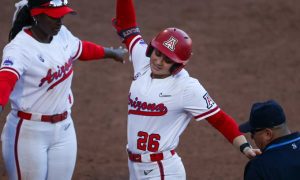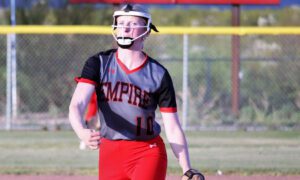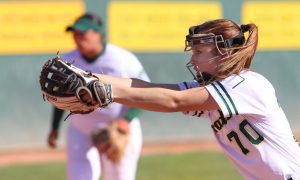FOLLOW @JAVIERJMORALES ON TWITTER!
[rps-paypal]
Nathan Bannister has been pumping strikes all year. Now he gets to take his show to #Omaha… #BearDown pic.twitter.com/4hDjsFMPQm
— Arizona Baseball (@ArizonaBaseball) June 15, 2016
Arizona has been abusing pitchers all. freaking. year. https://t.co/JuLvSwHuLO
— keithlaw (@keithlaw) June 11, 2016

Keith Law, of ESPN, is a member of the Baseball Writers Association of America
ESPN baseball writer Keith Law, known for his Twitter tirades, has taken Arizona coach Jay Johnson and pitching coach Dave Lawn to task about their alleged “misuse” of pitchers this postseason.
Law went so far as to Tweet, “Arizona has been abusing pitchers all. freaking. year.”
What has Law up in arms (sorry for the pun) is that Johnson and Law utilized right-hander Kevin Ginkel to close out a game against Louisiana-Lafayette and then started and pitched 5 2/3 innings that same day in Arizona’s 3-1 victory over the Ragin’ Cajuns that qualified the Wildcats for the Super Regional at Mississippi State last weekend.
Arizona ace Nathan Bannister also threw 198 pitches in two starts on two-days rest in the Lafayette Regional in games June 3 against Sam Houston State and June 6 against Lafayette.
Law’s claim that Arizona has abused pitchers all season was made after somebody tweeted to him that Bobby Dalbec was at 126 pitches with a 1-0 lead in the bottom of the ninth at Mississippi State on Friday.
“Wonder how much (the) Red Sox appreciate that?” the tweet reads. Boston drafted Dalbec, a right-hander, in the fourth round last week. Dalbec finished at 129 pitches in the game, relieved by Cameron Ming with two outs in the ninth.
The Arizona Daily Star’s Zack Rosenblatt wrote an article published yesterday with the headline: “Arizona’s pitchers aren’t overused as College World Series approaches”
In the article, Rosenblatt writes of a unique approach by Johnson that he adopted from former Point Loma Nazarene University coach Scott Sarver, of whom he was an assistant coach from 2002 to 2004. Rosenblatt describes Arizona’s use of more naps for pitchers to “trick the body”, believing sufficient rest has taken place. Here’s an excerpt:
“Arizona’s pitchers were put on a stricter sleep schedule, for example, during the regional series. After Bannister pitched the June 3 game, he tweaked his schedule to include more naps. The naps ‘trick the body,’ Lawn said. It’s a concept UA coach Jay Johnson adopted from Scott Sarver, the former coach at Point Loma Nazarene University.
‘I think it’s good,’ Johnson said. ‘We did some unique things during the regional in terms of their sleep and rest patterns in terms of them having naps, waking up, work out, eat, go back to bed, to give them almost a simulation of another day’s rest.
‘I just pay attention to everything. … (Sarver) came up with that one time, so that’s been in my back pocket for a long time but this is the first chance I’ve had to use it.'”
Law’s response to this article, aimed at Rosenblatt:
@MichaelJLev @ZackBlatt By the way, did you fact-check this arrant nonsense about naps "tricking the body?"
— keithlaw (@keithlaw) June 15, 2016
Law, a Harvard graduate, has not offered specifics about how Arizona has misused its pitchers all season. Rosenblatt touched on that subject in the article.
Lawn is quoted in the article as saying, “We can do what we do now because we don’t do it, contrary to what others are saying, throughout the year. I mean, it’s October baseball (comparing the major leagues with college baseball, which schedules its postseason in June). It’s done everywhere. It’s done everywhere, but for some reason, our situation stuck out.”
I weighed in on this debate with Law through Twitter:
.@keithlaw Keith, Want to read something from u breaking down how each CWS coach uses his pitchers. Not lazy enuf to do that? Broaden scope.
— Javier Morales (@JavierJMorales) June 15, 2016
Law did not respond to my tweet (I’m probably not viewed as significant enough in stature to him since he is at ESPN), so I decided to look into the pitching statistics of the eight teams involved in the College World Series and how the coaches involved used their pitchers.
What gets lost in this discussion is Arizona was put in an unfavorable position with the inclement weather at Lafayette. The rainouts and delays put the Wildcats in a situation to play four games in two days. Any team, especially in a win-or-else postseason setting, will be forced to utilize its pitchers a different way.
Bannister’s pitch count reached 198 in the two starts at Lafayette, but it is by no means a normal practice for Johnson and Lawn to work their pitchers to that extreme in a weekend series.
Law’s claim that Ginkel was overused from one game to the next at Lafayette is also worth scrutinizing. In those two games, Ginkel pitched only a combined 7 1/3 innings with 85 pitches. Nothing outrageous about that in one day’s work. Ginkel pitched the previous day but only 1 1/3 innings in relief, throwing 24 pitches.
Here are the highest pitch counts this postseason for the teams remaining in the College World Series:
[table “” not found /]Observations:
— Bannister and Dalbec have the most innings pitched with each throwing in three games (Dalbec pitched one inning relief in the Lafayette Regional). Eight other pitchers have thrown at least 200 pitches all in two starts with Miami’s Michael Mediavilla with the most at 227.
— Bannister and Dalbec have combined for 35 2/3 innings in the postseason, the most by any duo among the College World Series teams. The next highest is Jared Janczak and Brian Howard of TCU with 28 1/3 innings pitched. Janczak and Howard each have pitched in two games.
U of Arizona baseball having a field day of pitcher misuse. Kevin Ginkel faces 4 batters to close game one, comes back to start game two
— keithlaw (@keithlaw) June 7, 2016
— Two pitchers in the list above have worked extensively over four games: Florida’s Dane Dunning and Texas Tech’s Hayden Howard. Dunning threw 53 pitches over five innings of relief in two games in the Gainesville Regional. He threw 6 2/3 innings of relief, totaling 122 pitches, in two games at Florida State last weekend. Howard’s four appearances are also all in relief. He threw 86 pitches in two games (5 2/3 innings) at the Lubbock Regional. Last week in the Super Regional against visiting East Carolina, he pitched 60 innings in consecutive days (4 2/3 innings).
— Miami, Arizona’s opening opponent in the College World Series, has also used reliever Andrew Cabezas four times in the postseason. Last weekend against Boston College, he pitched 2 1/3 innings to close the game (37 pitches). He started the next day and pitched 2 2/3 innings, throwing 47 times, in the Hurricanes’ 9-4 win.
mommas don't let your babies pitch for the University of Arizona (because they abuse arms) https://t.co/oySsjiJpw4
— keithlaw (@keithlaw) June 6, 2016
— Cabezas ending a game in relief and starting the next day was not publicized to the degree of Ginkel doing the same thing, albeit in the same day, in the Lafayette Regional.
Arizona was the only team in a peculiar position of having to play four games in two days in the Lafayette Regional because of the weather. UC Santa Barbara also had a game postponed in the Nashville Regional but the Gauchos managed to advance with a 3-0 record. They were not forced to utilize their pitchers more than Arizona, which had to advance through the elimination rounds.
We don’t know how other coaches would have used their pitchers if in the same position as Johnson.
Based on the data and information provided (how other coaches utilize their pitchers), since Law’s assertion that Arizona abuses its pitchers, you can decide if in fact that is the case.
Johnson and Lawn have used Bannister and Dalbec extensively, and Ginkel was called upon to close and start in successive games, but it is questionable they should be called out by a national baseball writer for being abusive.
ALLSPORTSTUCSON.com publisher, writer and editor Javier Morales is a former Arizona Press Club award winner. He is a former Arizona Daily Star beat reporter for the Arizona basketball team, including when the Wildcats won the 1996-97 NCAA title. He has also written articles for CollegeAD.com, Bleacher Report, Lindy’s Sports, TucsonCitizen.com, The Arizona Republic, Sporting News and Baseball America, among many other publications. He has also authored the book “The Highest Form of Living”, which is available at Amazon.





























